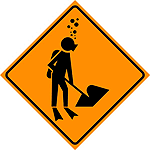|
| |

|
|
| < Prev. month |
Next month > |

|
This page under construction.
Here are some of the topics that will be covered in this chapter. More text and images will eventually be added to this section. Thank you for your patience.
|
- Phytoplankton and zooplankton populations decrease rapidly once the first winter storms arrive in November. Warm-water species are replaced by species that can tolerate downwelling and low levels of light and nutrients. Pennate diatoms and dinoflagellates may bloom sporadically, but soon fade to low levels after repeated storms.
- By December and January, the amount of chlorophyll and phytoplankton biomass (especially diatoms) reaches the lowest levels of the year.
- Although fresh water runoff from rivers brings nutrients to the coastal waters, and creates a thin layer of stable water near the surface, this layer is only a few meters thick, and is rapidly mixed with deeper water by storm winds. This limits phytoplankton blooms to the surface waters and protected areas close to the coast, and even these blooms don't usually last more than a few days.
- Diatom blooms sometimes occur during in December, featuring species that are also common in the early spring blooms in January and February (e.g. Skeletonema costatum and Thalassiosira decipens). Dinoflagellate blooms may also occur (e.g. Peridinium trochoideum and Gymnodinium splendens)
- Currents and winds from the south tend to keep drifting algae, zooplankton, and larvae close to shore. These relatively productive nearshore zones attract small fish such as anchovies, as well as marine mammals and seabirds.
- With relatively few microscopic algae and animals present, food is in short supply for fish and seabirds, especially in offshore waters. Similarly, the amount of marine snow sinking from surface waters into the deep sea (and providing food for deep-sea animals) reaches a minimum in December and January.
- Young-of-the-year rockfish (those born the previous spring and summer) move from nearshore waters out toward the outer continental shelf and continental slope. Some will migrate back toward shore during calm periods between storms.
- Many bottom-dwelling fish, such as California halibut, Starry flounder, Dover sole, English sole, and some deepwater rockfish (boccacio, darkblotched rockfish, canary rockfish, vermillion rockfish, and chilipepper), head to deeper water in November to spawn. Many of the "winter-spawning rockfish" release live young in December and January.
- In December, juvenile Longspine thornyhead (a deep-water relative of the rockfish) settle to the deep waters of submarine canyons and the continental slope after 18 months as drifting larvae.
- Market squid congregate to winter spawning areas in Monterey Bay, providing a welcome food source for bottom animals, seabirds, and marine mammals.
- Rock crabs (Cancer antennarius) and Dungeness Crabs lay eggs in November. Female crabs will carry these eggs for a month or two before the eggs hatch in December or January. The fishery for Dungeness crabs typically opens in late November, but only male crabs can be taken.
- Like Dungeness crabs, female giant pacific octopus brood eggs on deep rocks throughout the winter months.
- Brachiopods also spawn on the continental slope during the winter months, releasing sperm and eggs that will turn into larvae and then settle down to the seafloor in a few days.
- California hydrocoral colonies spawn in October and November in rocky parts of the continental shelf, releasing tiny larvae that settle on the seafloor near their parents.
- After feeding and growing up off the Pacific Northwest during summer and fall, hake migrate southward in November and December to spawn in estuaries and protected waters in Central and Southern California.
- Salmon migrate up rain-swollen streams and rivers to spawn. Cojo ("silver") salmon return to the sea after spawning. King Salmon die after spawning.

|
| |
